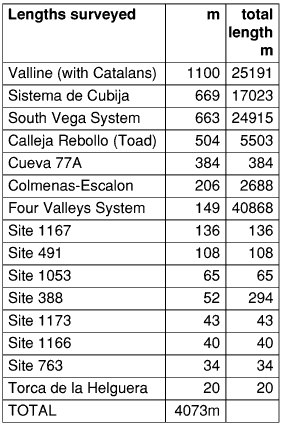Matienzo '96
Cave exploration around the Matienzo depression during 1996
amended from an article by Juan Corrin in Caves & Caving 75
Cavers during the 26th year of British Speleological Expeditions to Matienzo surveyed over 4km of new cave passage, taking the total of explored cave in the area to over 200km, with about 1220 catalogued sites of speleological interest. The explorations mainly occurred during Easter, a few days in June and over a five week period in July and August. There were no major discoveries this year, some loose ends were explored and various leads found to explore during 1997. The main discoveries are listed in the table.
 The
South Vega System and Cueva Valline
The
South Vega System and Cueva Valline
These two caves, on the north and south sides of a 688m high hillside,
continue to creep closer together. The systems are being jointly explored
by the Matienzo and Tortosa cavers.
In Cueva Valline (site 733), most new passage in 1996 was discovered
in the "old cave" by pushing and surveying passages which had
not be fully explored during the original explorations. The upstream Rio
Rioja was dived by Rupert Skorupka and continues through sump 2 to sump
3 where the passage remains inviting.
In the South Vega System (consisting of Torca Azpilicueta (333), Torca
de Coterón (264), Torca de la Vera Negra (36) and Cubio de la Reñada
(48)), explorations at Easter at the far upstream end continued during
one trip in the summer to find a long streamway, The China Syndrome, which
ended at a huge aven which could be bolted in the future. This point lies
some 500m north of Cueva Valline and 150m below.
In Torca de la Vera Negra some pushing was carried out in the East Wanders
with the intention of pushing towards Valline which is apparently on a
similar level 1km to the south. No significant progress was made.
During a push up a boulder choke in Breakdown Chamber in Cubio de la
Reñada, Graham Hart from Plymouth dislodged a boulder, fell and
broke his leg in four places. The ups and downs in the roomy but muddy
entrance series, which are normally given scarcely a thought, provided
"fun and games" for the dozen cavers it took to bring him out
over eleven hours.
The Caves of North Vega
Cueva de la Morenuca (site 774) was almost doubled in length and extended
to link with the Cubija System at Easter. This set of caves now consists
of Torca de Mostajo (71), Torca de Regaton (892) and Morenuca. The nearby
Torca de la Calleja Rebollo (Toad in the Hole, 258) was extended by 500m
in small passage to bring the length to 5.5km. In the Sistema de Colmenas-Escalon
(site 363) tidying up found just 200m of passage.
The Four Valley System
A small amount of passage was surveyed in Cueva Hoyuca (Uzueka, site
107), near to Straw Inlet. In Secadura, a draughting cave known since the
seventies, Cueva 77A (site 154), was pushed through boulders into a bouldery
cave with flooded lower levels (see survey). Although less than 400m long,
this is a significant find, next to the cave behind the main resurgence
(site 117) for the Matienzo water.
San Miguel
A major dive using helium was carried out by Rupert Skorupka in Peter
Plummet (site 239), the over flow for the Nacimiento del Rio Clarion. He
reached a depth of over 74m where the shaft was seen to carry on with no
bottom in sight. (See Caves & Caving 73).
Science
As part of the ongoing scientific study of the Matienzo karst, a water
quality monitoring programme was initiated this year. The aim of this project
is to quantify solute flux through the Matienzo depression. A combination
probe and associated data logging facility, comprising of SENTEC direct
ION electrodes to monitor water hardness and dissolved calcium load, were
installed in the main streamway of Cueva Molino (Cueva del Agua, site 59).
A logging interval of 30mins was set giving an estimated six month time
scale for data collection. The site will be revisited within this time
scale to replenish batteries and extend the sampling period. It is hoped
to expand the instrumentation level in the near future in particular to
give a more accurate indication of discharge. The assistance, with this
project, of the Ghar Parau Foundation and the William Pengelly Cave Studies
Trust is duly acknowledged. (Andy Quin)
Acknowledgements
Thanks are due to the caving and regional authorities who provide the
necessary permits, and the many friends in Matienzo and Spanish caving
groups who make us so welcome. In addition to the Ghar Parau Foundation
and William Pengelly grants mentioned above, a sum of £440 was received
from the Foundation for Sport and the Arts: thanks are due to all these
bodies.
Recent References
- The Hidden Depths of Peter Plummet in Caves & Caving 73, Autumn 1996
- Matienzo '95 in Caves & Caving 70, Winter 1995
- Matienzo '94 in Caves & Caving 66, Winter 1994
- Matienzo '93 in Caves & Caving 63, Spring 1994